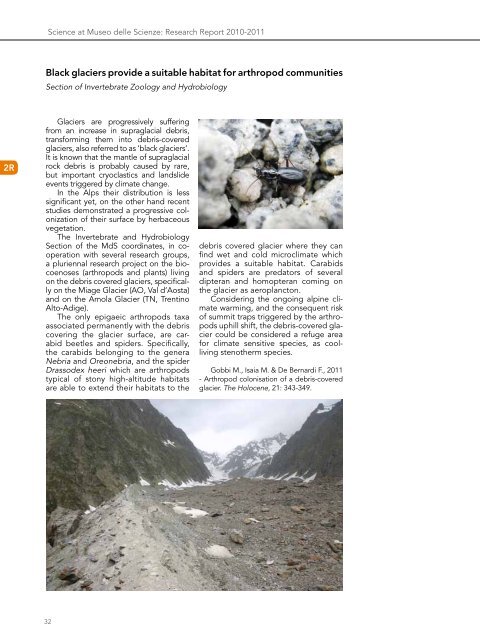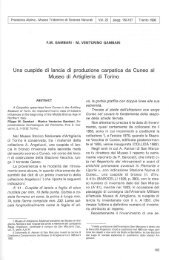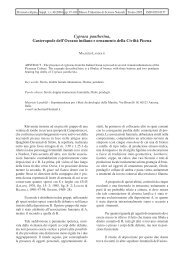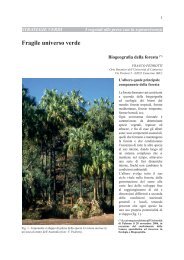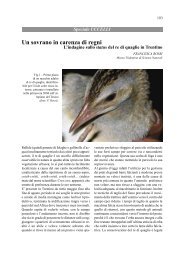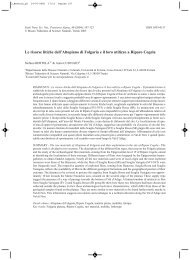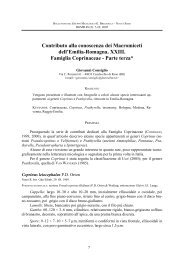Science at Museo delle Scienze - Museo Tridentino di Scienze ...
Science at Museo delle Scienze - Museo Tridentino di Scienze ...
Science at Museo delle Scienze - Museo Tridentino di Scienze ...
Create successful ePaper yourself
Turn your PDF publications into a flip-book with our unique Google optimized e-Paper software.
1R<br />
2r<br />
2R<br />
3R<br />
4R<br />
5R<br />
6R<br />
<strong>Science</strong> <strong>at</strong> <strong>Museo</strong> <strong>delle</strong> <strong>Scienze</strong>: Research Report 2010-2011<br />
black glaciers provide a suitable habit<strong>at</strong> for arthropod communities<br />
Section of Invertebr<strong>at</strong>e Zoology and Hydrobiology<br />
Glaciers are progressively suffering<br />
from an increase in supraglacial debris,<br />
transforming them into debris-covered<br />
glaciers, also referred to as ‘black glaciers’.<br />
it is known th<strong>at</strong> the mantle of supraglacial<br />
rock debris is probably caused by rare,<br />
but important cryoclastics and landslide<br />
events triggered by clim<strong>at</strong>e change.<br />
in the Alps their <strong>di</strong>stribution is less<br />
significant yet, on the other hand recent<br />
stu<strong>di</strong>es demonstr<strong>at</strong>ed a progressive coloniz<strong>at</strong>ion<br />
of their surface by herbaceous<br />
veget<strong>at</strong>ion.<br />
The invertebr<strong>at</strong>e and hydrobiology<br />
section of the Mds coor<strong>di</strong>n<strong>at</strong>es, in cooper<strong>at</strong>ion<br />
with several research groups,<br />
a pluriennal research project on the biocoenoses<br />
(arthropods and plants) living<br />
on the debris covered glaciers, specifically<br />
on the Miage Glacier (Ao, Val d’Aosta)<br />
and on the Amola Glacier (Tn, Trentino<br />
Alto-A<strong>di</strong>ge).<br />
The only epigaeic arthropods taxa<br />
associ<strong>at</strong>ed permanently with the debris<br />
covering the glacier surface, are carabid<br />
beetles and spiders. specifically,<br />
the carabids belonging to the genera<br />
Nebria and Oreonebria, and the spider<br />
Drassodex heeri which are arthropods<br />
typical of stony high-altitude habit<strong>at</strong>s<br />
are able to extend their habit<strong>at</strong>s to the<br />
32<br />
debris covered glacier where they can<br />
find wet and cold microclim<strong>at</strong>e which<br />
provides a suitable habit<strong>at</strong>. carabids<br />
and spiders are pred<strong>at</strong>ors of several<br />
<strong>di</strong>pteran and homopteran coming on<br />
the glacier as aeroplancton.<br />
considering the ongoing alpine clim<strong>at</strong>e<br />
warming, and the consequent risk<br />
of summit traps triggered by the arthropods<br />
uphill shift, the debris-covered glacier<br />
could be considered a refuge area<br />
for clim<strong>at</strong>e sensitive species, as coolliving<br />
stenotherm species.<br />
Gobbi M., isaia M. & de Bernar<strong>di</strong> F., 2011<br />
- Arthropod colonis<strong>at</strong>ion of a debris-covered<br />
glacier. The Holocene, 21: 343-349.


